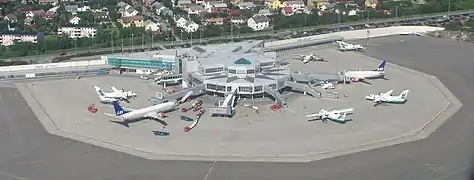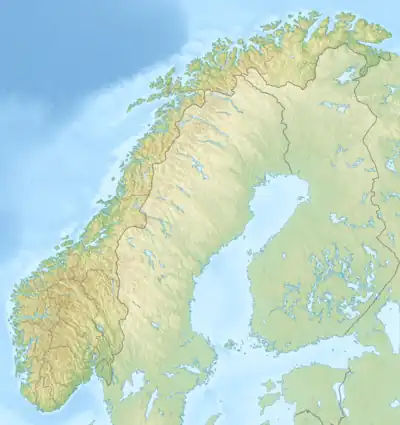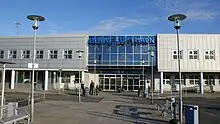Bodø Airport Bodø lufthavn | |||||||||||
|---|---|---|---|---|---|---|---|---|---|---|---|
 | |||||||||||
| Summary | |||||||||||
| Airport type | Joint (public and military) | ||||||||||
| Operator | Avinor | ||||||||||
| Serves | Bodø, Norway | ||||||||||
| Location | Bodø | ||||||||||
| Focus city for | Widerøe | ||||||||||
| Elevation AMSL | 13 m / 43 ft | ||||||||||
| Coordinates | 67°16′09″N 014°21′55″E / 67.26917°N 14.36528°E | ||||||||||
| Website | avinor.no | ||||||||||
| Map | |||||||||||
 BOO | |||||||||||
| Runways | |||||||||||
| |||||||||||
| Statistics (2018) | |||||||||||
| |||||||||||
Bodø Airport (Norwegian: Bodø lufthavn; IATA: BOO, ICAO: ENBO) is a civil airport in the town of Bodø in Bodø Municipality in Nordland county, Norway. Located just south of the city centre, on the westernmost tip of the Bodø peninsula, it shares facilities with the military air force base Bodø Main Air Station. The airport has a single concrete, 2,794 by 45 metres (9,167 by 148 ft) runway which runs in a roughly east–west direction.[4] In addition to jet operations to major domestic destinations, the airport serves as a hub for regional airline flights to Helgeland, Lofoten and Vesterålen.[5]
A new airport could be ready in the last half of 2029, according to media's paraphrasing (in January 2022) of Avinor. Planning is in progress to build a new airport about one kilometer (0.6 miles) south and build a new smart city district on the site of the current airport. The smart city will be largely focused on transportation and sustainability.[6]
History
Postal flights to Bodø started in 1921, and before 1940 Bodø was served with sea planes from Widerøe.
The first runway at Bodø Airport was built during World War II by British troops, after Germany had invaded Norway. On 26 May 1940, three Royal Air Force Gloster Gladiators, led by Flight Lieutenant Caesar Hull, landed and made the first airborne defence for the city. The area was swampland, and the first makeshift runway consisted of wooden planks floating on the water. Soon the German Luftwaffe seized control over the airport and held it for the duration of the war, among other things upgrading the runway to concrete.
Not much was done with the airport until after the Korean War started in 1950. The West were afraid of a Soviet attack on Western Europe, so a new military base was constructed at a new location south-west of the old one. Originally planned to be finished in 1951, the new airport did not become fully operational until 1956, though the civilian terminal opened in 1952. From then on, fighter jets have been stationed at Bodø. In 1988, NATO injected vast amounts of money to enable the airfield to handle large air forces in the event of an emergency.
The airport was used during the testing of Concorde in June 1975.[7]
In the early 1980s, the current civilian terminal was discussed and planned. The Norwegian Ministry of Finance approved the project early in 1988. The construction started a few weeks after its approval and was completed in spring 1990. The terminal has 11 gates, three with jetways. Since its opening in 1990, the number of passengers increased from 820,000 to 1,700,000 in 2013.
Air force base
The Bodø Main Air Station, situated adjacent to the airport, is the largest air station in Norway operated by the Royal Norwegian Air Force. This air station is the home of the 331st and the 332nd Squadrons equipped with General Dynamics F-16 Fighting Falcons in addition to a detachment from the 330th Squadron of Westland Sea King helicopters.
Airlines and destinations
The airport is a hub for regional flights between Trondheim and Tromsø, in addition to being served by more than ten daily return flights to Oslo. Several international seasonal routes are also served.[8]
| Airlines | Destinations |
|---|---|
| Finnair | Seasonal: Helsinki[9] |
| Lufttransport | Værøy |
| Norwegian Air Shuttle | Oslo Seasonal charter: Gran Canaria[8] |
| Scandinavian Airlines | Oslo, Tromsø, Trondheim Seasonal charter: Chania,[8] Palma de Mallorca[8] |
| Sunclass Airlines | Seasonal charter: Gran Canaria[8] |
| Widerøe | Andenes, Bergen, Brønnøysund, Harstad/Narvik, Kristiansand,[10] Leknes, Mo i Rana, Mosjøen, Namsos, Rørvik, Røst, Sandefjord, Sandnessjøen, Stavanger,[10] Stokmarknes, Svolvær, Tromsø, Trondheim[11] |
Statistics


Ground transport
The airport is very near the city centre, about 1.5 km distance, and from the railway station 2.0 km. Travel to the airport can be done by local bus, by taxi, or by foot. There are also regional buses from the airport.
Norwegian Aviation Museum
The Norwegian Aviation Museum is located next to the airport in a propeller-shaped building. An aviation centre at the airport was approved by parliament on 31 March 1992, and opened on 15 May 1994. The military part – Luftfartsmuseet (the Aviation Museum) was opened in May 1995. The Norwegian Aviation Museum was formed on 1 January 1998, founded by the government, the local city council of Bodø and the county council of Nordland. The museum is a "national museum" and funded through the national budget.
The museum exhibits several military aircraft including a Lockheed U-2, a Gloster Gladiator and a Supermarine Spitfire. There are also some civilian aircraft on display such as the de Havilland Canada DHC-3 Otter, a Junkers Ju 52/3m on floats, and a Fokker F.28-1000 Fellowship.
Accidents and incidents
- Lockheed U-2 spy aircraft were stationed at Bodø in 1958. On 1 May 1960, a U-2 piloted by Gary Powers was headed for Bodø from Pakistan but was shot down, causing the U-2 Crisis of 1960.
- Finnish Beechcraft V35B Bonanza, OH-BBD, disappeared 24 June 1974 in foul weather on its approach to Bodø ENBO. It carried a five member Saami council and the pilot. [12]
- On 4 December 2003, a Dornier 228 of Kato Airline operating as Flight 603 was struck by lightning, causing a fracture to the control rod that operated the elevator. The aircraft subsequently landed heavily just short of the runway at Bodø and was written off. Both crew members sustained serious injuries while both passengers sustained slight injuries.[13]
- On 29 September 2004, an asylum-seeker armed with an axe attacked the pilot of Kato Airline flight 605 from Narvik-Framnes, causing the aircraft, a Dornier 228, to go into a dive. The assailant was overpowered by passengers, including Odd Eriksen, later a member of the government (Minister of Commerce), and the aircraft made a safe landing at Bodø.[14]
References
- ↑ "Airport information for ENBO" (PDF). Avinor. Archived from the original (PDF) on 1 February 2014. Retrieved 21 January 2014.
- ↑ "Passenger statistics from Avinor" (xlsx). Avinor. Retrieved 6 May 2016.
- ↑ "Aircraft movement statistics from Avinor". Avinor. Archived from the original (xlsx) on 18 April 2016. Retrieved 6 May 2016.
- ↑ "ENBO - Bodo Airport | SkyVector". skyvector.com. Retrieved 2023-07-18.
- ↑ Nina (2018-02-09). "Northern Norway's 'biggest move ever'". Norway's News in English — www.newsinenglish.no. Retrieved 2023-07-18.
- ↑ "The city in the city: The Norwegian smart city being developed from the ground up".
- ↑ "Concorde 1975 | gamlebodo.com". Archived from the original on 2022-01-13. Retrieved 2021-02-28.
- 1 2 3 4 5 "Bodø Airport - Avinor". avinor.no.
- ↑ "Finnair adds Bodø seasonal service in S20".
- 1 2 Liu, Jim. "Widerøe schedules new routes June - Aug 2020". Routesonline. Retrieved 21 May 2020.
- ↑ "Destinasjoner | Widerøe". www.wideroe.no.
- ↑ "Suomen oma lentomysteeri – 6 katosi jäljettömiin 40 vuotta sitten". 18 March 2014.
- ↑ "Report on the aircraft accident at Bodø Airport on 4 December 2003 involving Dornier Do 228-202 LN-HTA, operated by Kato Airline AS" (PDF). Accident Investigation Board Norway. Retrieved 11 March 2008.
- ↑ "Two tenths of a second from disaster". NRK. 2 December 2018. Retrieved 19 April 2021.
External links
![]() Media related to Bodø Airport at Wikimedia Commons
Media related to Bodø Airport at Wikimedia Commons